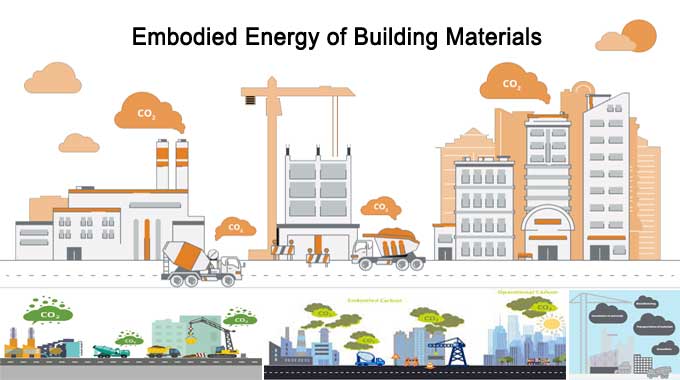
A Study of the Embodied Energy of Building Materials

In the case of building materials, embodied energy is the sum total of the energy needed for extraction, processing, manufacturing and delivering the materials to the building site.
Since CO2 emissions are produced by energy consumption, embodied energy is considered an indicator of the overall environmental impact of building materials. As a parameter of the built environment's sustainability, embodied energy is incorporated into assessments of the life cycle of buildings.
Define Embodied Energy
Embodied energy is the total amount of nonrenewable energy consumed by building materials throughout their entire life cycle, including extraction, manufacturing, construction, maintenance, and disposal.
To put it another way, it measures how much greenhouse gas emissions the material is responsible for throughout its lifespan.
The embodied energy method is different from the life cycle assessment, which considers all the impacts of a material through its life cycle. Materials are not included in the operation or disposal process. Product or service embodied energy refers to the energy used during production.
Proper Reason of Reducing Embodied Energy
It is possible to approximate the environmental impact of the material by measuring its energy consumption during manufacture, and for most building materials, the major environmental impact occurs during the manufacturing process.
As embodied energy accounts for twenty percent of a building's energy consumption, reducing it can have a significant impact on the environment overall.
In many cases, a building material or system with a higher embodied energy may be justified, since it reduces the operating energy requirements of the building over its serviceable life. Even though aluminum has a high embodied energy, it is a durable and long lasting material.
Building materials' embodied energy becomes increasingly important as the energy efficiency of a building improves, reducing energy consumption.
Types of Embodied Energy
Initial Embodied Energy: In the process of procuring raw materials, processing them, manufacturing them, transporting them, and constructing them, nonrenewable energy is consumed. A steel window, for example, has embodied energy from mining the ore, producing, transporting, manufacturing, and transporting it to the construction site. A building material's source, type, and nature influence its initial embodied energy.
Recurring Embodied Energy: Maintenance, repair, restoration, refurbishment, or replacement of materials, components, or systems consumes non renewable energy. As well as the longevity of the building, it is influenced by the durability and maintenance of the building materials, systems, and components.
Operating Energy: In the construction industry, initial embodied energy is of primary importance. Energy is used by passive or active energy systems to heat, cool, ventilate, and illuminate buildings. When a building ages, its operating energy increases, and the original embodied energy becomes irrelevant.
Cement production produces less than seven percent of the world's CO2 emissions, making concrete the most abundant human made material in the world.
Until 2050, embodied carbon is expected to account for nearly half of new construction's carbon footprint. Depletion of resources, production of greenhouse gases, and degradation of the environment are all caused by it.
Mega Joules or Giga Joules are units of initial embodied energy per unit of weight or area. Embedded energy is calculated through a complex process that depends on the location of the manufacturing technology & the production method.
How to Study Embodied Energy of Building Materials
Civil engineers and architects should be most concerned with reducing carbon emissions from buildings.
1. Cement, aluminum, and steel production consume large amounts of nonrenewable energy, which is why they must be used with care in building construction.
To learn more, watch the following video tutorial.
Video Source: Vidya-mitra
2. It is essential to analyze and measure the embodied energy in building materials to create more eco-friendly projects.
3. Life Cycle Assessments are useful for identifying the aspects of a building's life cycle that have the greatest environmental impact. In assessing different materials that serve the same purpose, you must compare different materials like steel, timber, or concrete frame.
4. Architecture and construction decisions can be made with a greater understanding of embodied energy rather than fashion or profit in mind.
5. Local materials should be used along with the building should be designed for low maintenance, flexible in use, and suitable for the climate to reduce embodied energy in a building.


